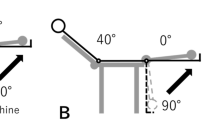Abstract
Muscle force potentiation affects force output during electrical stimulation. Few studies have examined stimulation train parameters that influence potentiation such as pulse number, stimulation frequency, train duration, and force–time integral and peak force produced during the train. Pulse-matched trains (100 pulses) at 7.5, 15, 25, 30, 50, and 100 Hz, and trains of varying pulse number (50, 100, and 200 pulses) at 30 and 50 Hz were delivered to the ulnar nerve of 10 (5 male, 5 female; 23.4 ± 0.9 years), healthy individuals in random order. Single twitches of the adductor pollicis muscle were elicited before and after each train with a rest interval of at least 5 min between each train. No differences in potentiation occurred across the pulse-matched trains at frequencies of 15–50 Hz (38.9 ± 5.4–44.6 ± 5.5%). Twitch force potentiation following the highest (100 Hz) and lowest (7.5 Hz) frequency trains were not significantly different and were lower than the other 100 pulse-matched trains. As pulse number increased, potentiation increased for both the 30 and 50-Hz trains. There was a significant positive correlation between force potentiation and force–time integral produced by the stimulation train, r = 0.70. The results indicate that potentiation magnitude is dependent on the force–time integral produced during the test train and the number of pulses delivered, independent of stimulation frequency.









Similar content being viewed by others
References
Binder-Macleod SA, Dean JC, Ding J (2002) Electrical stimulation factors in potentiation of human quadriceps femoris. Muscle Nerve 25:271–279
Blinks JR, Rudel R, Taylor SR (1978) Calcium transients in isolated amphibian skeletal muscle fibres: detection with aequorin. J Physiol 277:291–323
Borovikov YS, Levitsky D (1989) The effect of myosin light chain phosphorylation and Mg2+ on the conformation of myosin in thick filaments of glycerinated fibers of rabbit skeletal muscle. Eur J Biochem 183:83–88
Brown GL, von Euler US (1938) The after effects of a tetanus on mammalian muscle. J Physiol 93:39–60
Close R, Hoh JFY (1968) The after-effects of repetitive stimulation on the isometric twitch contraction of rat fast skeletal muscle. J Physiol 97:461–477
Gibson H, Cooper RG, Stokes MJ, Edwards RHT (1988) Mechanisms resisting fatigue in isometrically contracting human skeletal muscle. Q J Exp Physiol 73:903–914
Greenberg MJ, Mealy TR, Watt JD, Jones M, Szczesna-Cordary D, Moore JR (2009) The molecular effects of skeletal muscle myosin regulatory light chain phosphorylation. Am J Physiol Regul Integr Comp Physiol 297:R265–R274
Hamada T, Sale DG, MacDougall JD (2000) Postactivation potentiation, fiber type, and twitch contraction time in human knee extensor muscles. J Appl Physiol 88:2131–2137
Houston ME, Green HJ, Stull JT (1985) Myosin light chain phosphorylation and isometric twitch potentiation in intact human muscle. Pflugers Arch 403:348–352
Johnson MA, Polgar J, Weightman D, Appleton D (1973) Data on distribution of fibre types in thirty-six human muscles. An autopsy study. J Neurol Sci 18:111–129
Krarup C (1981) Enhancement and diminution of mechanical tension evoked by staircase and by tetanus in rat muscle. J Physiol 311:355–372
Loiselle DS, Walmsley B (1982) Cost of force development as a function of stimulus rate in rat soleus muscle. Am J Physiol (Cell Physiol) 12:C242–C246
MacIntosh BR, Willis JC (2000) Force–frequency relationship and potentiation in mammalian skeletal muscle. J Appl Physiol 88:2088–2096
Moore RL, Stull JT (1984) Myosin light chain phosphorylation in fast and slow skeletal muscles in situ. Am J Physiol Cell Physiol 247:C462–C471
Persechini A, Stull JT, Cooke R (1985) The effect of myosin phosphorylation on the contractile properties of skinned rabbit skeletal muscle fibers. J Biol Chem 260:7951–7954
Round JM, Jones DA, Chapman SJ, Edwards RHT, Ward PS, Fodden DL (1984) The anatomy and fibre type composition of the human adductor pollicis in relation to its contractile properties. J Neurol Sci 66:263–293
Small SC, Stokes MJ (1992) Stimulation frequency and force potentiation in the human adductor pollicis muscle. Eur J Appl Physiol 65:229–233
Sweeney HL, Bowman BF, Stull JT (1993) Myosin light chain phosphorylation in vertebrate striated muscle: regulation and function. Am J Physiol Cell Physiol 264:C1085–C1095
Uyeda TQP, Abramson PD, Spudich JA (1996) The neck region of the myosin motor domain acts as a lever arm to generate movement. Proc Natl Acad Sci USA 93:4459–4464
Vandervoort AA, Quinlan J, McComas AJ (1983) Twitch potentiation after voluntary contraction. Exp Neurol 81:141–152
Acknowledgments
We would like to thank Viviana Cintolesi for her contribution to this study. The experiments performed for this study were performed in the USA and were in compliance with the current laws and regulations. All procedures were approved by the Internal Review Board at the University of Texas at Austin and were in accordance with the Helsinki Declaration. We would also like to thank artist Nick Johnson for creating the schematic.
Conflict of interest
The authors declare that they have no conflict of interest.
Author information
Authors and Affiliations
Corresponding author
Additional information
Communicated by Håkan Westerblad.
Rights and permissions
About this article
Cite this article
Mettler, J.A., Griffin, L. What are the stimulation parameters that affect the extent of twitch force potentiation in the adductor pollicis muscle?. Eur J Appl Physiol 110, 1235–1242 (2010). https://doi.org/10.1007/s00421-010-1625-1
Accepted:
Published:
Issue Date:
DOI: https://doi.org/10.1007/s00421-010-1625-1




